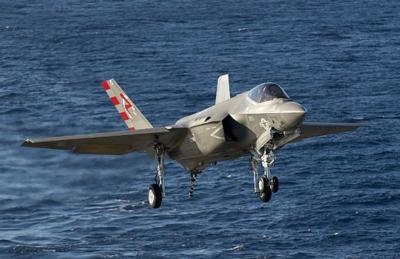Fri, Dec 05, 2014
Developed Cost-Saving Method For Manufacturing Canopies For The Aircraft
The Office of Naval Research (ONR) received one of the nation's top manufacturing awards for an innovative, cost-saving method for making advanced cockpit enclosures, or canopies, for the F-35 Lightning II Joint Strike Fighter program Dec. 2.

Officials from ONR's Manufacturing Technology (ManTech) program accepted the Department of Defense's Joint Defense Manufacturing Technology Achievement Award at the Defense Manufacturing Conference in San Antonio.
The Department of Defense's Joint Strike Fighter program is developing the next generation of affordable, lethal strike aircraft in variants for the Navy, Air Force and Marine Corps. The automated process will be used to make canopies (the transparent shells around the cockpits) for more than 2,000 aircraft, saving nearly $125 million over the life of the F-35 program.
ONR ManTech led a team of military and industry scientists and engineers in automating the thermoforming process used to create F-35 canopies, saving time and money and eliminating potential hazards for human work crews. "This award confirms our commitment to developing the most efficient and cost-effective ways to manufacture some of the most critical hardware our Sailors and Marines use," said John Carney, director of ONR's ManTech program.
The automation project began in 2011 and cost just $1.3 million. Much of the work was carried out at the Composites Manufacturing Technology Center, one of seven Centers of Excellence under ONR's ManTech program. "The potential cost savings represent a huge return on a relatively small initial investment by ONR," said Neil Graf, ONR ManTech's program officer.
The F-35 canopy represents the cutting edge in aircraft design. Its unique shape and specialized material the make the canopy manufacturing process more complex than that for other aircraft.

Currently, skilled technicians load an acrylic shell into a forming tool and load the assembly into an oven heated to 200 degrees where the canopy forms over a span of up to six days. During that time, workers regularly enter the oven to makes observations and manually adjust positioning clamps to control the forming process. The new method uses a control system with cameras to see inside the oven to calculate the rate at which the canopy's shape is forming. The clamps automatically adjust to ensure the shape remains uniform throughout the process to meet the F-35's stringent requirements.
The new system gets the job done in just two or three days. It also requires fewer tools and oven time and less clean-up afterward. Most importantly, workers no longer have to enter the hot ovens.
The automated thermoforming process underscores the chief of naval operations' Navigation Plan that calls for the service to continue efforts to make investments to address near-term challenges and develop future capabilities even in the face of budget constraints.
ONR ManTech partnered with experts from the F-35 Program Office, Naval Air Systems Command, GKN Aerospace Transparency Systems and Penn State's Applied Research Laboratory to develop the automated system. GKN Aerospace Transparency Systems, in coordination with the F-35 Program Office, plans to implement the new process in May.
(Images provided by the U.S. Navy)
More News
From 2021: The Inside Skinny On What Being An ANN Oshkosh Stringer Is All About By ANN Senior Stringer Extraordinare, Gene Yarbrough The annual gathering at Oshkosh is a right of p>[...]
Video Showed That During The Takeoff, The Nose Baggage Door Was Open On May 10, 2025, about 0935 eastern daylight time, a Piper PA-32RT-300, N30689, was destroyed when it was invol>[...]
Get The Latest in Aviation News NOW on Instagram Are you on Instagram yet? It's been around for a few years, quietly picking up traction mostly thanks to everybody's new obsession >[...]
"I think what is key, we have offered a bonus to air traffic controllers who are eligible to retire. We are going to pay them a 20% bonus on their salary to stay longer. Don't reti>[...]
Aero Linx: Pilot Briefing The gathering, translation, interpretation, and summarization of weather and aeronautical information into a form usable by the pilot or flight supervisor>[...]
 Oshkosh Memories: An Aero-News Stringer Perspective
Oshkosh Memories: An Aero-News Stringer Perspective NTSB Prelim: Piper PA32RT
NTSB Prelim: Piper PA32RT ANN FAQ: Follow Us On Instagram!
ANN FAQ: Follow Us On Instagram! Aero-News: Quote of the Day (05.28.25)
Aero-News: Quote of the Day (05.28.25) ANN's Daily Aero-Term (05.28.25): Pilot Briefing
ANN's Daily Aero-Term (05.28.25): Pilot Briefing




